Fish food XXL - a comparison of different types of food for the aquarium
Table of contents
- Basic information on the amount of food
- Live food
- Frozen food
- Fresh food
- Making your own fish food
- Ready-made food
- Epilogue
When it comes to fish food, there is a colourful market of possibilities and a choice that makes you dizzy. Feeding fish in the aquarium is not as easy as it might seem at first glance - our aquarium fish come from incredibly diverse biotopes and feed in very different ways. The fact that a rasping growth eater cannot eat the same as a slender, fast predator fish is actually obvious!
Basic information on feed quantity
Practically every fish food has the potential to pollute the aquarium water, so when feeding, you should only ever give an amount that your aquarium fish will eat in a reasonable amount of time. Any uneaten food should be removed from the aquarium to prevent it from going bad.
Live food
Omnivorous and carnivorous aquarium fish - i.e. omnivores and carnivores - are particularly happy with live food in the aquarium. In nature, many ornamental fish eat insect larvae, small crustaceans, worms, approach food (i.e. insects that land on the water surface), small water snails, sometimes even mussels, ... Predatory fish also eat invertebrates, but also prey on other fish.
Since the German Animal Welfare Act only permits the feeding of vertebrates (which, as we all know, includes fish) in exceptional cases, it is easiest for the aquarium if you use invertebrate food: white mosquito larvae, black mosquito larvae and red mosquito larvae, mayfly larvae, water lice, water fleas, amphipods, copepods, Artemia nauplii (for the very small ornamental fish) and adult Artemia, Tubifex, shiner worms, Grindal, microworms, banana worms and pickle worms (also for the very small aquarium fish). As initial food for very small fish larvae, slipper lizards, rotifers and other protozoa are a good choice.
Pool live food
Pond food is always well received - freshly pooled live food is always a hit with fish! Please make sure that you only pond in waters where no fish live, so that you don't accidentally introduce fish parasites and pathogens into the aquarium! A good place to pond in summer is the rain barrel - here you will often find black mosquito larvae and, with a bit of luck, red mussels.
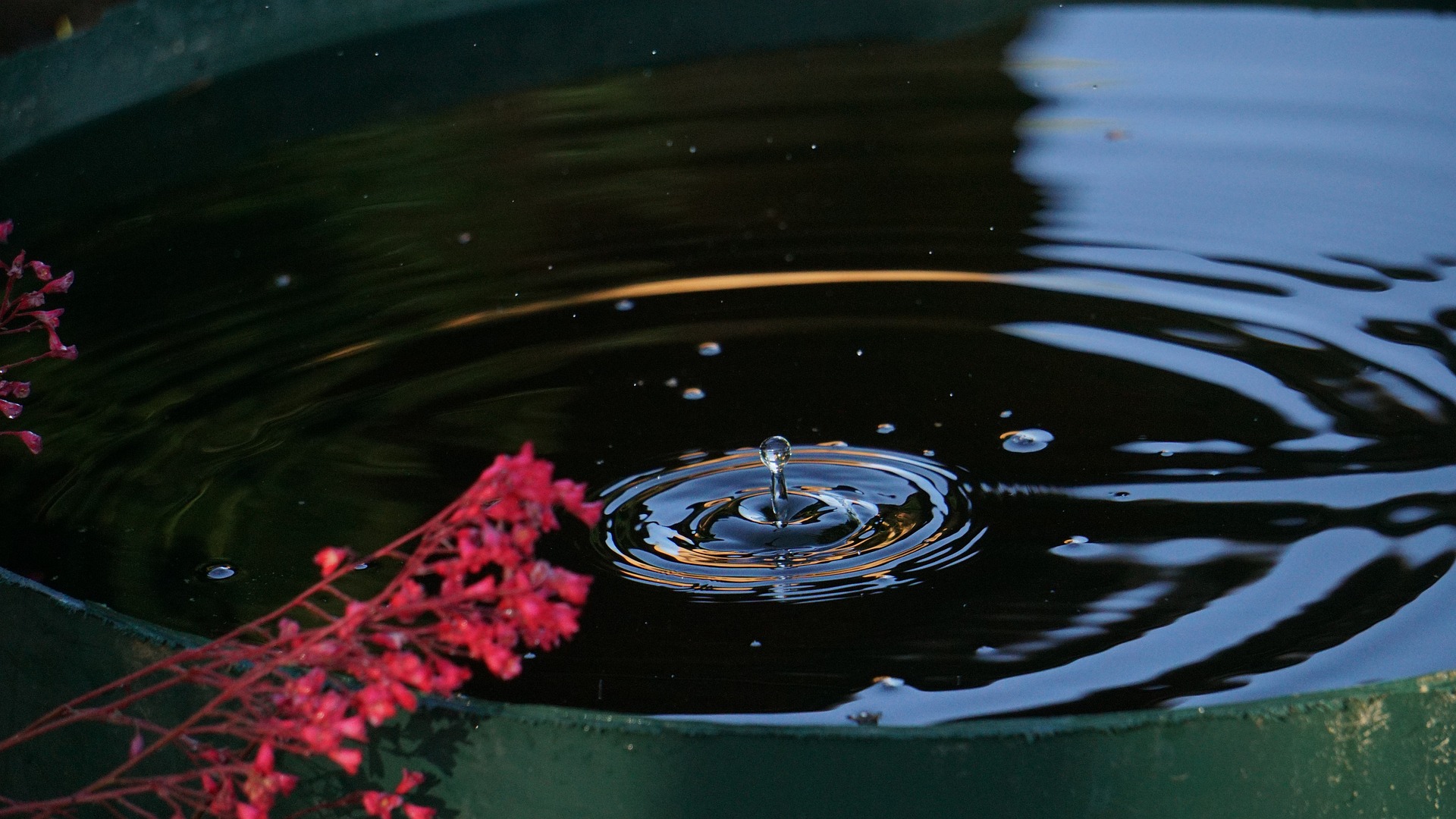
What do I need for pooling?
Actually, all you need for pooling, i.e. catching live food in natural waters or in rain barrels, is a larger aquarium landing net and a bucket with a lid. A shallow white bowl for sorting out dragonfly larvae, planaria, snails and the like is also good.
When can you start pooling?
In principle, the first mosquito larvae and water fleas can be found from the end of February or beginning of March. The pond season continues well into autumn - and even into winter.
Legal aspects of pond management
To take fish food from a body of water (i.e. to pond) you need the permission of the owner of the pond and, in some federal states, also the permission of the person entitled to fish (if the owner of the pond is not the same person). In some cases, you even need a fishing licence if you want to catch fish food from waters. It is therefore important to find out what the regulations are in your federal state before you set off armed with a landing net and bucket.
However, no one is interested in what you are doing in your rain barrel at home.
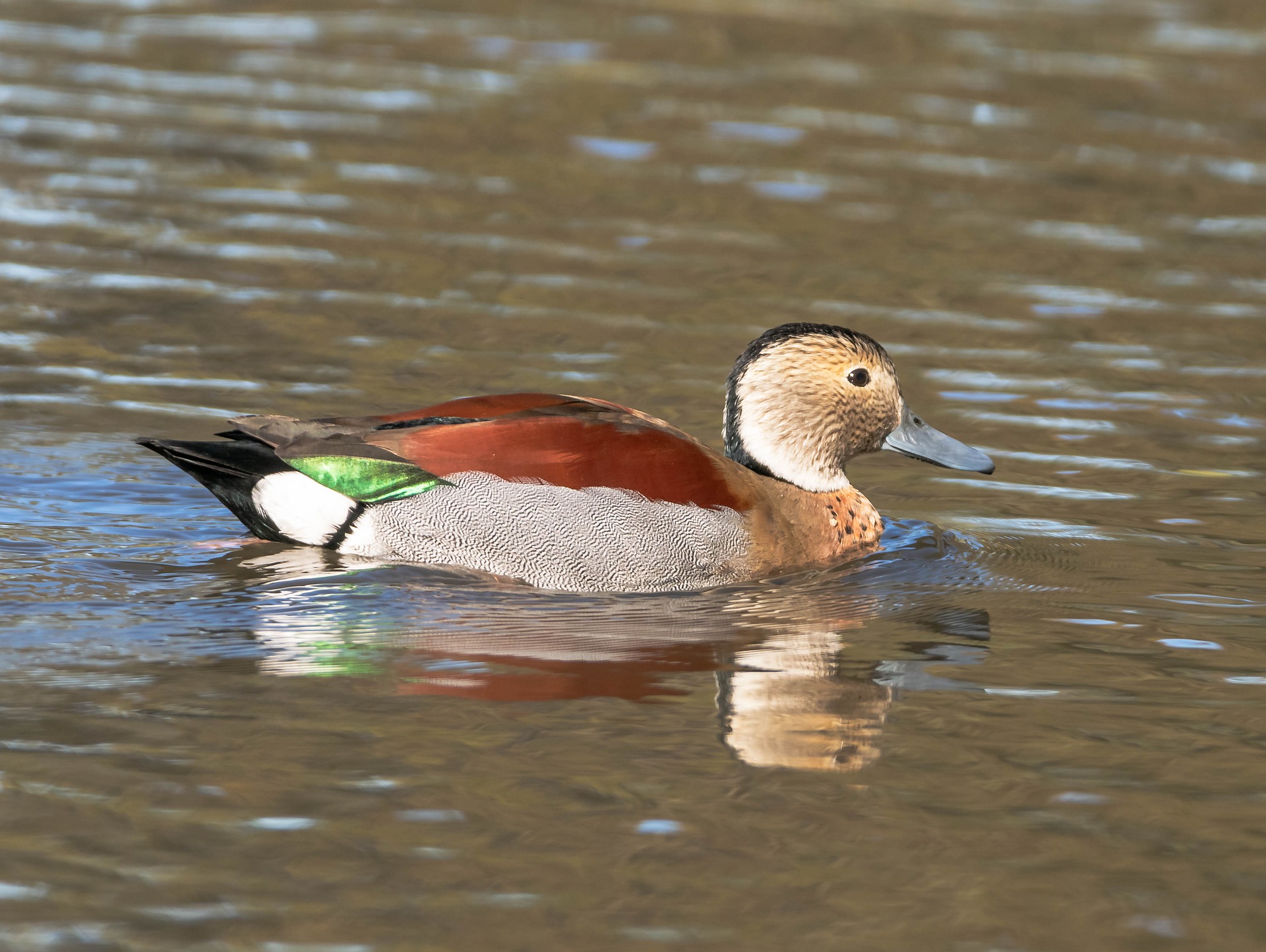
Grow your own live food
If you don't want to go through all the legal hassle of pond life, you can also grow some live food yourself. Here in the blog you will find various instructions for breeding live food for your fish and invertebrates in the aquarium:
- Slipper lizards for rearing small fish larvae and for shrimps<
- Breeding, keeping, propagating & feeding Artemia - All you need to know about Artemia
- Single-cell live food
- Insect larvae as live food - Mosquito larvae & Co
- Worms as live food in the aquarium for fish and co.
- Crustaceans as live food in the aquarium for fish and co.
- Instructions: Catching and breeding shiny worms is easy
You will see that breeding live food is fun - and feeding it is even more so! It's simply great when the fish hunt for their food, and you'll gain completely new insights and perspectives into their natural behaviour.
Frozen food
Many live foods are also available as frozen foods. In particular, you will find red mosquito larvae, black mosquito larvae, water fleas (daphnia), tubifex, gammarus, cyclops, bosmids, krill and mixtures of different types of frozen food.
Frozen food comes either pre-portioned in blister packs or as a frozen tablet for self-portioning.
Frozen food is suitable for feeding omnivorous and carnivorous aquarium fish. Invertebrates living at the bottom of the aquarium also benefit from frozen food, because frozen invertebrates sink faster than live food and thus find a richly laid table.
Getting wild fish used to frozen food
With a little patience you can get even sensitive wild fish to eat frozen food - give them their usual portion of live food and mix in some frozen food. The live food awakens the fish's hunting instinct, and in the course of the hunt the finned fish will also grab the odd piece of frozen food. Over time, reduce the amount of live food until the fish will only eat frozen food.
Fresh food
Vegetables, greens and leaves are favourite foods for many omnivorous and mainly herbivorous aquarium fish. Make sure that the fresh food is not sprayed or otherwise treated.
To be on the safe side, peel or scald vegetables and peel off the skin (e.g. tomatoes or peppers); your fish cannot eat the hard shells and skins anyway. You should also squeeze peas out of their shells.
Soft vegetables such as pumpkin and tomato, courgette and cucumber or peas can be eaten raw after shelling or peeling without further preparation. Harder vegetables such as carrots should be placed in boiling water for about 1-2 minutes. Green food (spinach, dandelion, Chinese cabbage etc.) should also be blanched briefly in boiling water to make it easier to eat. This breaks up the cell structure a bit and your fish can better scrape off some of their fresh food.
Many herbivores and omnivores, but also aufwuchsfresser, like to pick at autumn leaves and take the biofilms that form on them as a supplement to their diet. Rasping sucker catfish, for example, also like to eat the leaves themselves. If you briefly scald the brown leaves, they will perish immediately.
Fruit should be viewed quite critically in the aquarium, the sugar content can drive up the germ density in the aquarium and lead to bacterial blooms with oxygen depletion. Vegetables, greens and leaves are much better food for your fish in the aquarium!
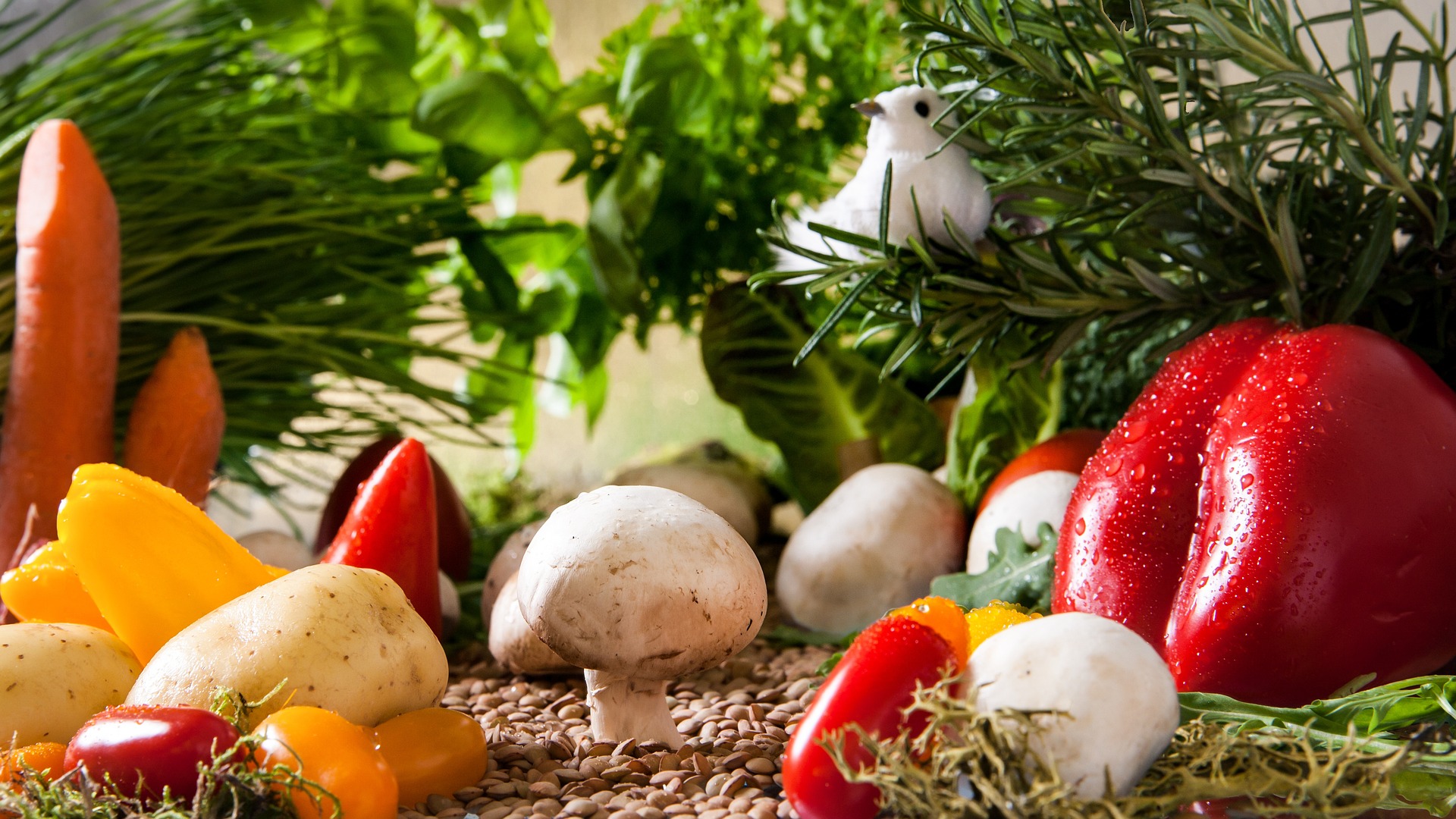
Finding the right amount of leaves, vegetables and green food
Brown autumn leaves do not contain many nutrients, but they are very valuable for your fish in the aquarium because of their high mineral density and the many fibres. You can give practically unlimited amounts of brown autumn leaves.
The situation is different with fresh food, however. Vegetables and greens contain relatively many nutrients, including various simple sugars and polysaccharides. Sugar in particular promotes bacterial growth in the aquarium water, so you should only give as much fresh food as your aquarium fish can eat in a day.
A lovingly prepared vegetable skewer, which could feed a large family if necessary, is usually far too rich for an aquarium. Take out any green food or vegetables that are not eaten before your water quality is affected.
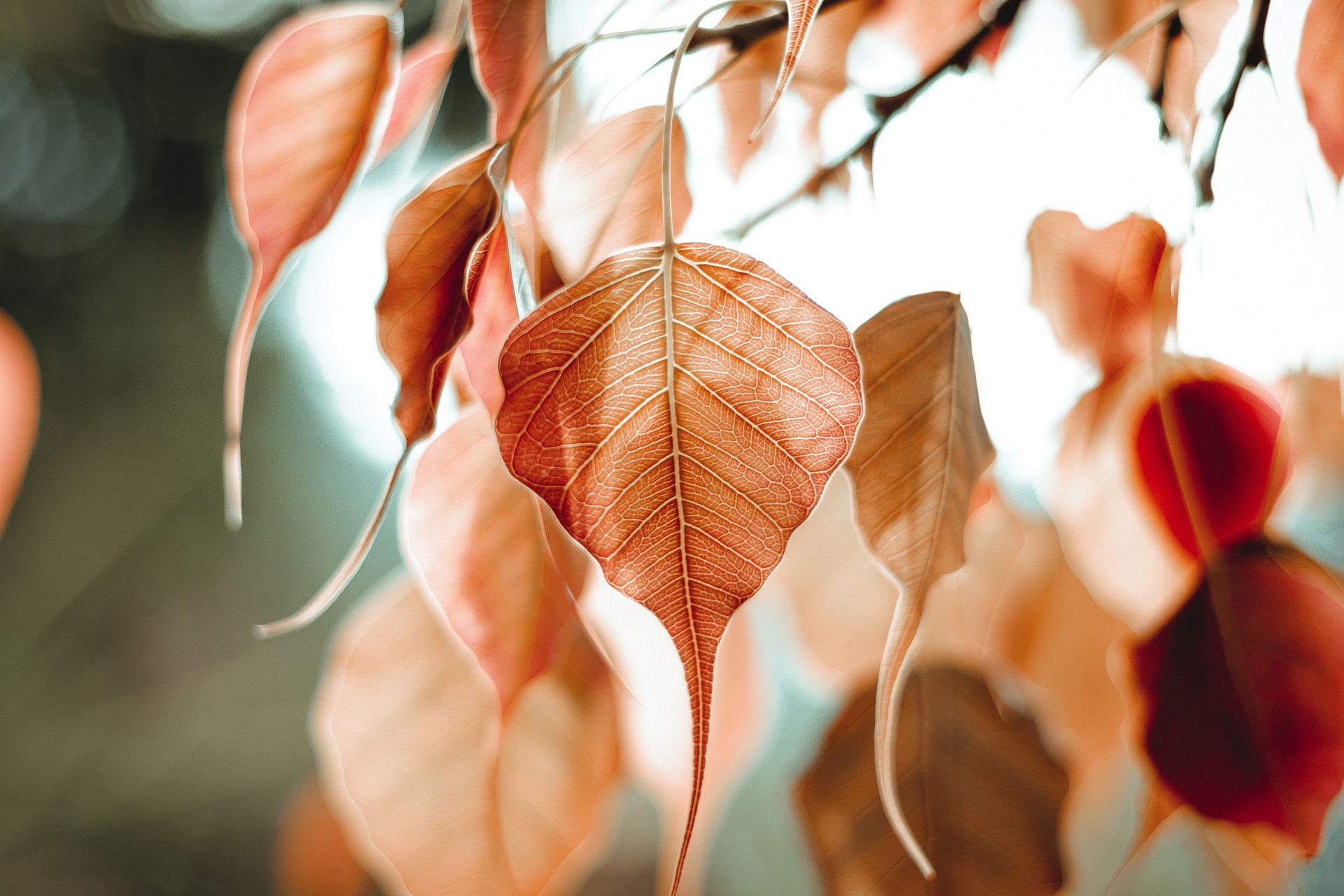
Make your own fish food
In theory, you can make your own fish food. Take a look at the fish you would like to feed and get the appropriate ingredients. You can finely grind the ingredients for your homemade fish food in a Moulinette or other blender.
For omnivorous aquarium fish, for example, a mixture of spirulina powder, dried gammarus (crayfish), dried spinach, dried pumpkin, dried green walnut leaves, dried daphnia (water fleas) and the like is good. You can also buy some of the ingredients already ground here in the shop!
For herbivorous fish, of course, choose only vegetable ingredients, for carnivorous fish only animal ingredients.
Mix as much water into the finely ground ingredients until the mixture is spreadable, and either squirt small "sausages" onto a baking tray with a decorative syringe from the baking supplies or spread the batter thinly onto the tray.
You can either let your homemade fish food air-dry in a dry, warm place or (especially if the humidity is high) in the oven at 50°C.
Stored in an airy package (paper bag or cardboard box), the homemade fish food for aquarium fish will keep for several weeks. Make sure that nothing moulds!
Ready-made food
At NatureHolic we have given a lot of thought to the nutrition of fish - we are convinced that fish in the aquarium should be fed as close to nature as possible. This means that our food has a soft consistency - just like the insect larvae that the ornamental fish would eat in nature. In this way, we avoid micro-injuries in the fish's mouth.
In the production of the food we pay attention to high-quality ingredients, we mix in valuable minerals and vitamins which are important for an all-round supply of the aquarium fish.
The foods in the NatureHolic fish food range are very well accepted by the aquarium fish. They do not cloud the water - neither during nor after feeding.
The high-quality ingredients make our fish food particularly easy to digest; nutrient absorption in the fish's intestines is extremely good. As a result, only very few excess nutrients get into the aquarium water with the fish faeces. The aquarium water remains much clearer as a result.
Feeding advice: Give your aquarium fish several times a day an amount that they can eat within a few minutes. You are not buying air or cheap fillers here. There's real power in NatureHolic fish food!
The NatureHolic Feed range
We have included our special NH complexes in all NatureHolic feeds. These useful feed supplements are what make our fish feed so valuable.
- NH Immune+ Complex: highly effective plant substances and prebiotic substances can improve the immune condition of the fish.
- NH Color+ High Performance Additive: five different colour boosters from the carotenoid family (beta-carotene, lutein, zeaxanthin, lycopene and astaxanthin) improve colours and can have a positive effect on the immune system and reproductive behaviour of the fish.
- NH Energy+ Complex: special amino acids and servatives such as L-carnitine or gamma-aminobutyric acid from professional aquaculture can improve the growth and condition of fish in the aquarium.
- NH Fulvin+ Complex:with the valuable germ-inhibiting humic substance fulvic acid or fulvic acid, which can bind pollutants, transport vitamins, trace elements and minerals and have a positive effect on digestion and the immune system.
Main feed flake and main feed granulate
For lovers of classic fish food, we have reinterpreted the classic flake food and spiced it up with our knowledge of modern fish nutrition. Not only NH complexes are used here, but also valuable salmon oil, medicinal herbs and beta glucans from natural yeasts.
We also use the same raw materials for our soft main feed granulate, which is just as well accepted by the fish.
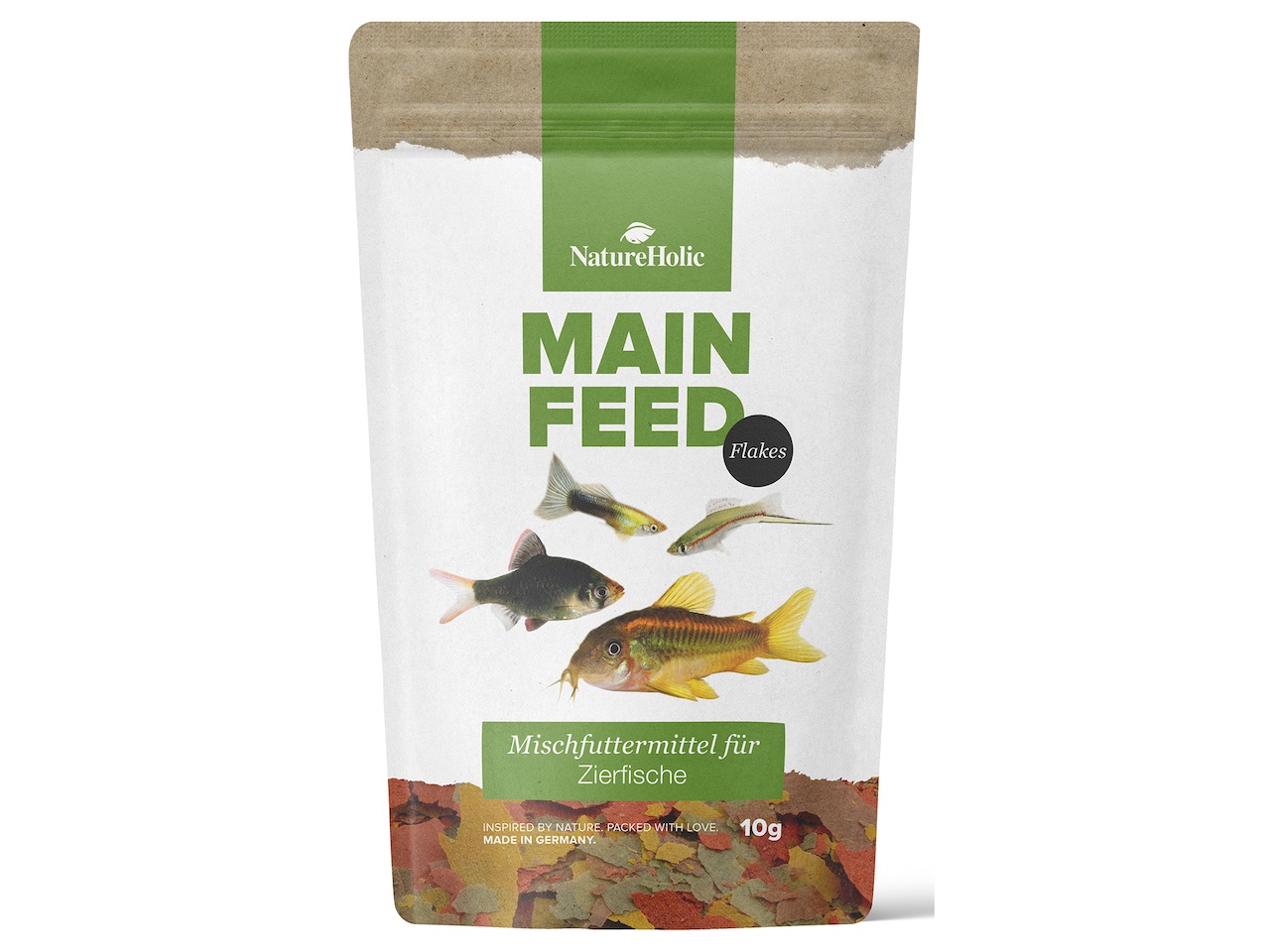
Nanofeed
We also use the proven composition of our NatureHolic main feed for our NatureHolic Nanofeed - only in tiny. This fine, soft feed granulate is ideal for nano fish with particularly small mouths - such as dwarf danios, particularly small tetras, small livebearers such as Endler guppies and other omnivorous, particularly small aquarium fish.
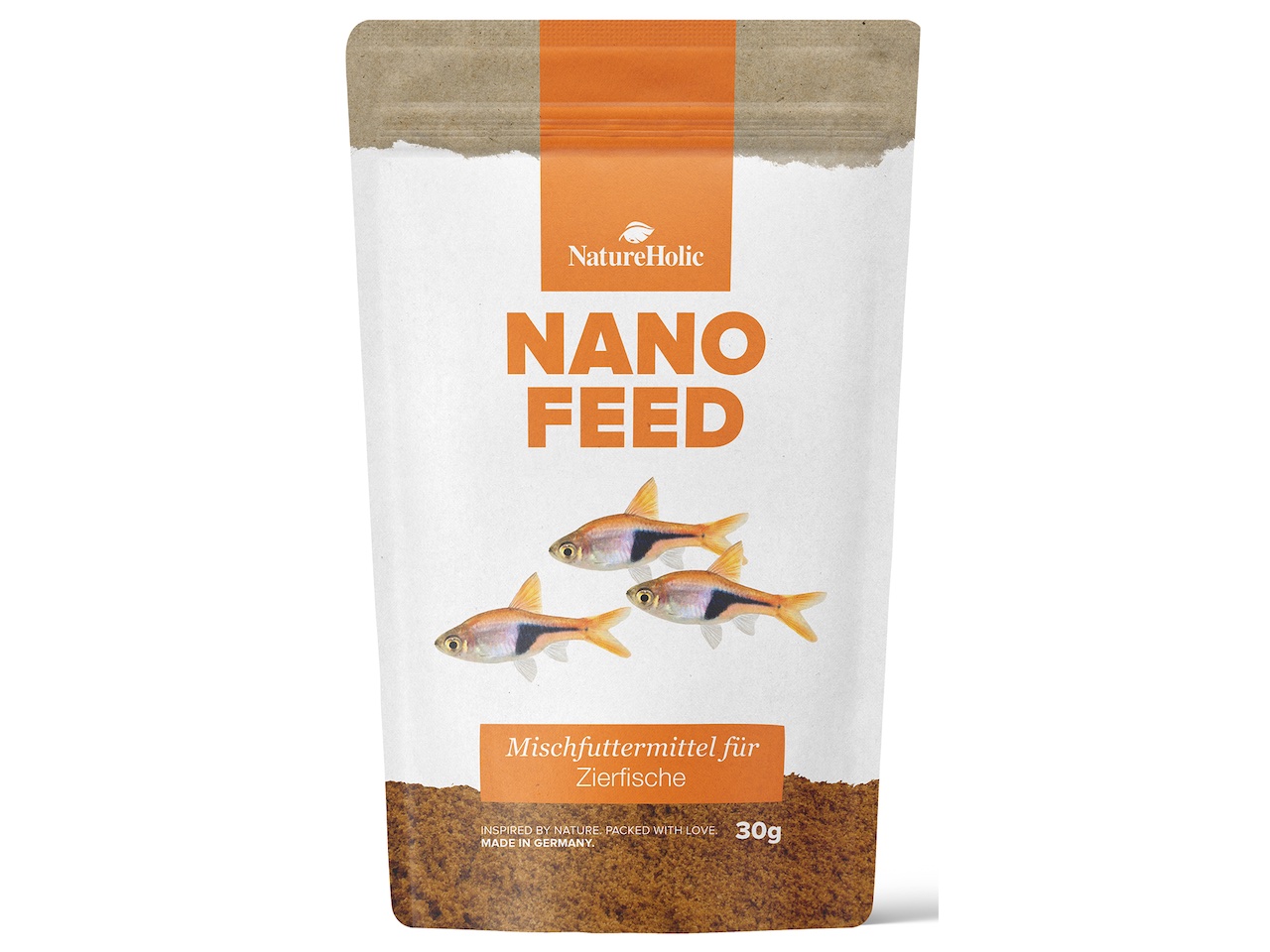
Youngfeed
This special rearing food for omnivorous young fish is especially finely ground and disperses very well in the aquarium water. The micro-fine consistency is perfect for even the smallest fish larvae in the rearing aquarium. Ideally, you should feed 2-3 times a day in quantities that your fish larvae and fry can eat within a few minutes.
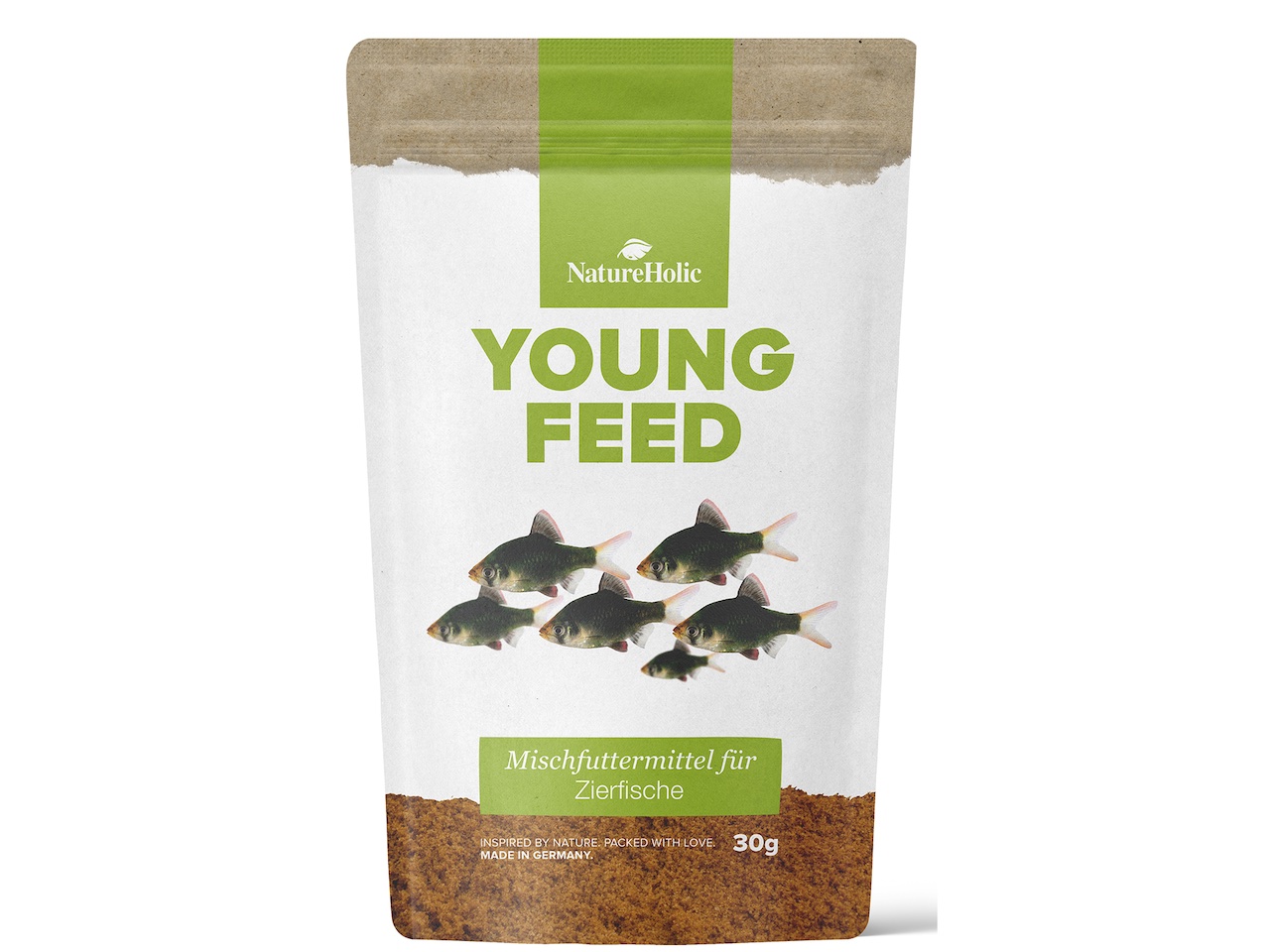
Guppyfeed
When selecting the ingredients for NatureHolic Guppyfeed, we have made sure that there is a sufficiently large vegetable content in the fish food for your live-bearing aquarium fish. Great for guppies, platies, swordtails, mollies and other livebearers - and also for other aquarium fish that like a higher vegetable content in their food.
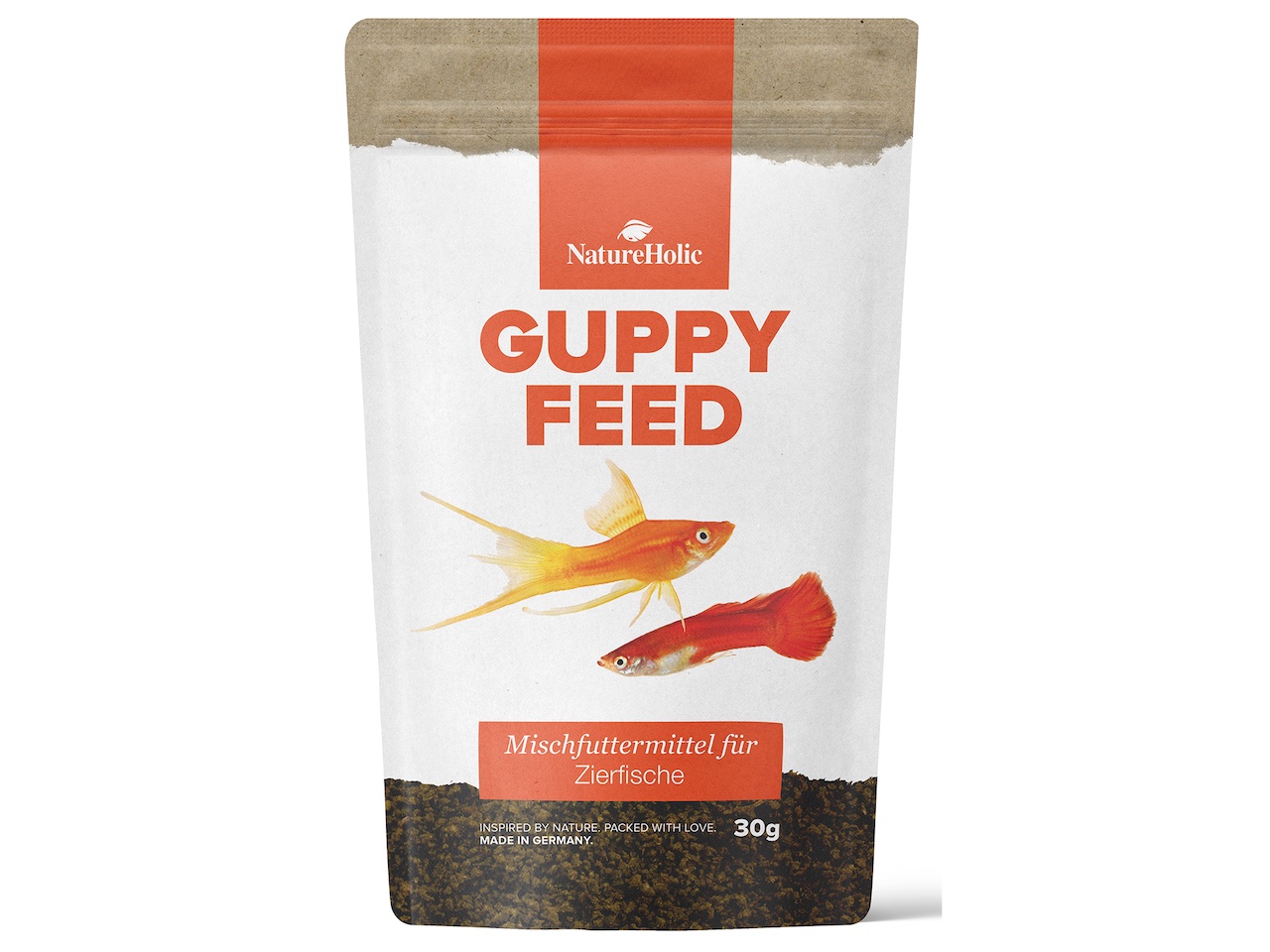
Cichfeed
NatureHolic Cichfeed has been formulated with the needs of predominantly carnivorous cichlids in the aquarium in mind. A small proportion of vegetable food imitates the intestinal contents of prey animals. Not only carnivorous cichlids love this tasty animal-based food, other larger carnivorous aquarium fish also like the tasty, slightly larger pieces.
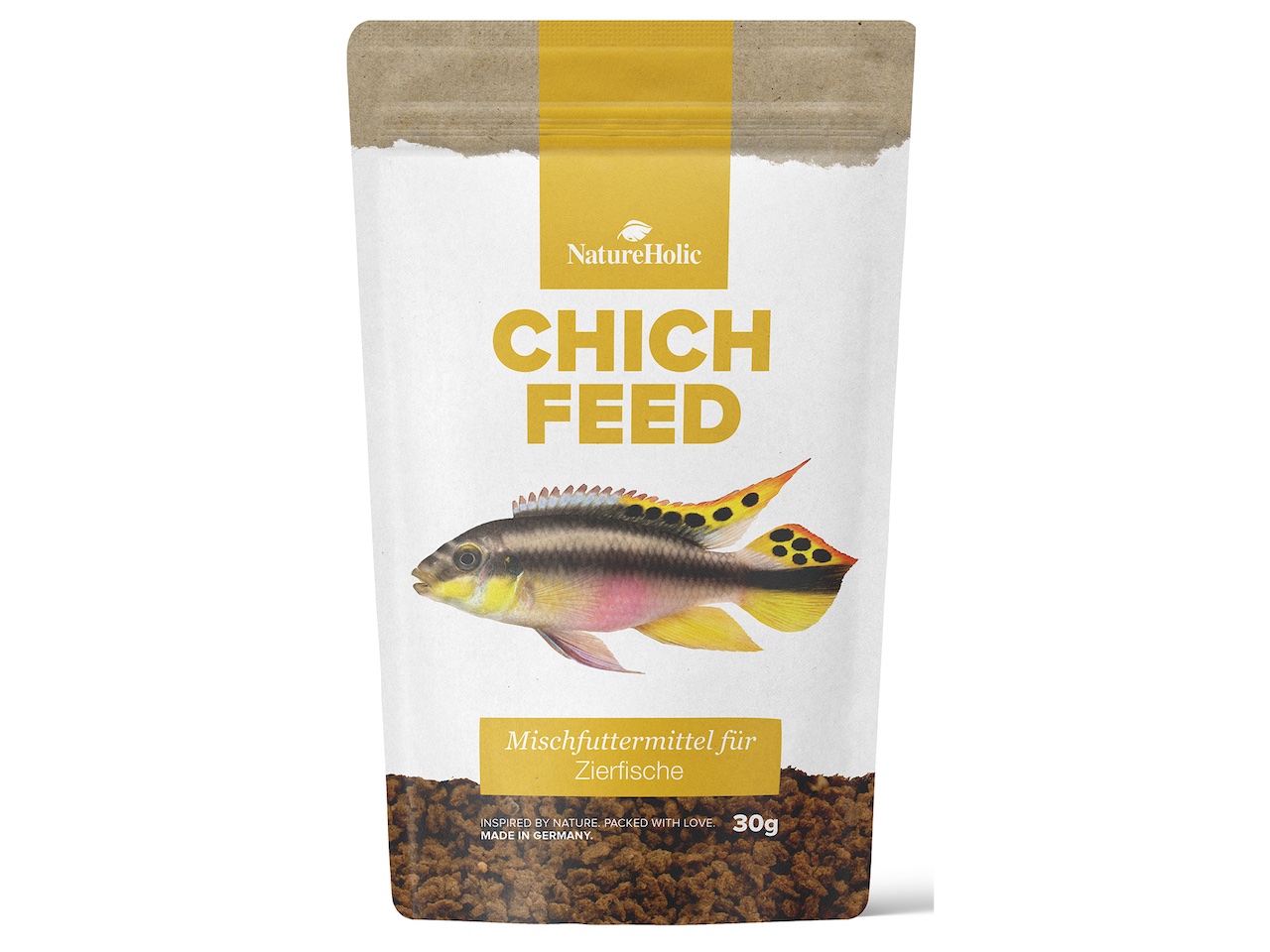
Bettafeed
NatureHolic Bettafeed largely follows our Cichfeed in its composition - Bettas are carnivores too! However, the grain size is finer and takes into account the somewhat smaller mouth of the fighting fish.
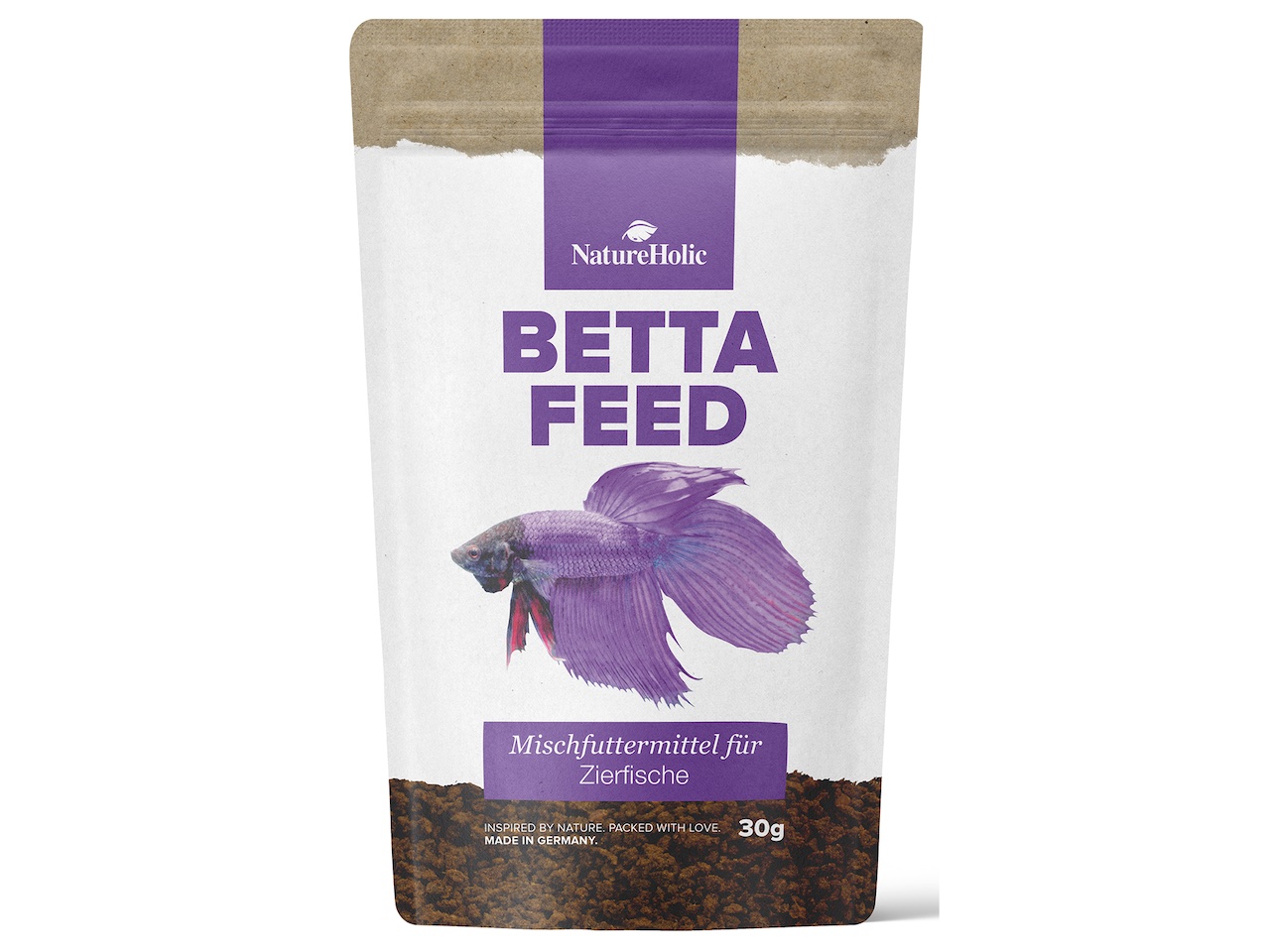
Catfish feed
The sinking larger food chips contain chitin as well as very important dietary fibres of vegetable origin, which are totally important for the smooth digestion of catfish in the aquarium. The relatively hard chips give your catfish something to scrape off and meet their natural need to scrape.
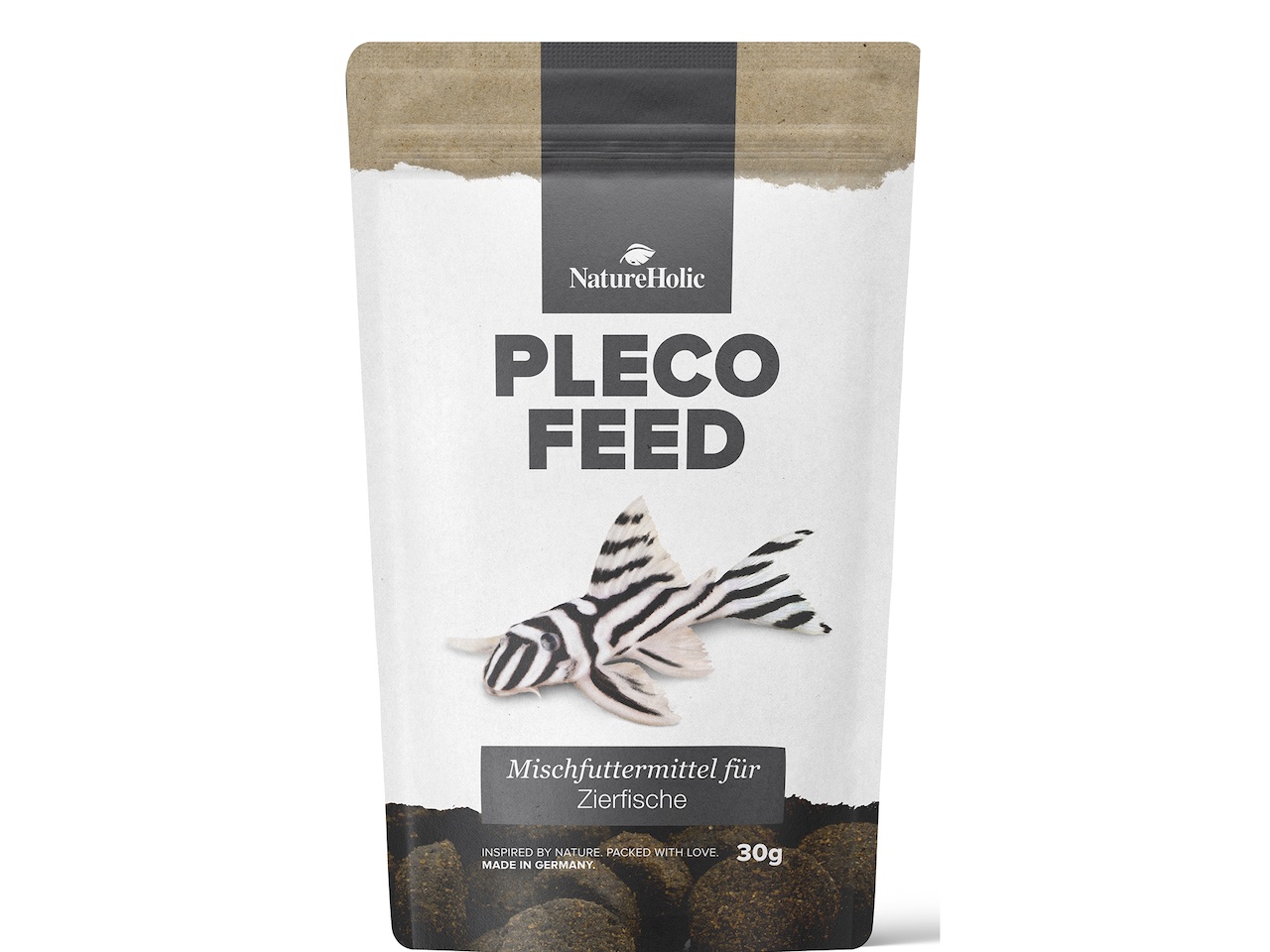
PurSnacks
Our NatureHolic PurSnacks are whole food animals embedded in tasty jelly. The five tasty varieties are:
PurSnacks are a great and very tasty alternative to live and frozen food. They are also very popular with fussy fish and wild fish in the aquarium.
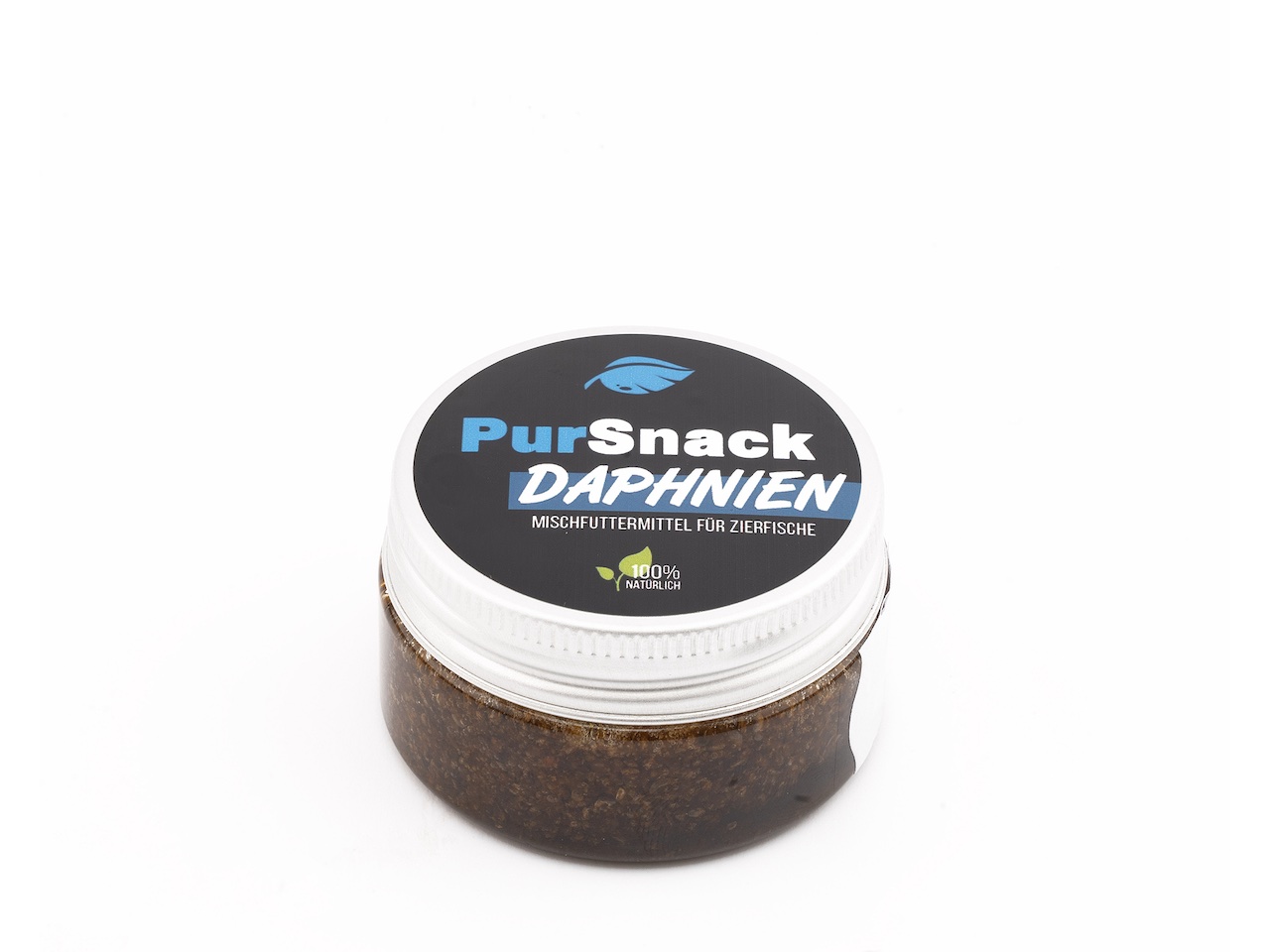
Bites
As a tasty snack for your omnivorous and herbivorous aquarium inhabitants we have developed our Pumpkin Cinnamon Bites with tasty pumpkin and germ-inhibiting cinnamon. For carnivorous aquarium fish there are the Insect Bites as a treat and high-quality snack.
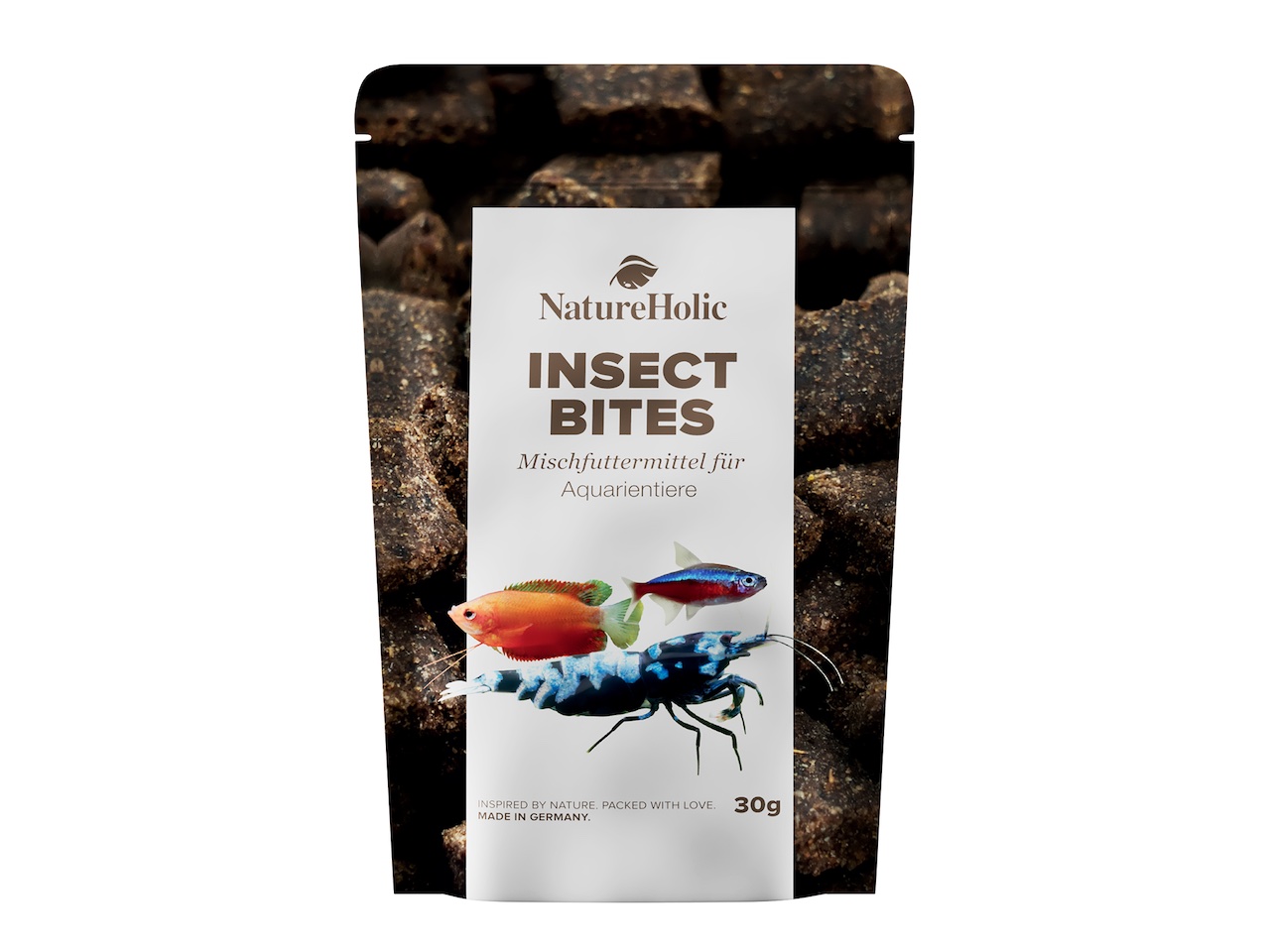
Chris and Oli's Premium Line
Our two aquarium experts Chris Lukhaup and Oli Knott got together with the Natureholic fish food specialists and developed our Black Label Premium range - here you can buy the perfect staple food for your aquarium fish. Free from cheap fishmeal and other inferior animal meals and without cheap fillers, you are buying the very highest quality food here. Carefully produced and excellently digestible, with high-quality raw materials from responsible sources. High-quality ingredients are environmental protection in action for us!
The animal content in Chris and Oli's food by NatureHolic consists of insects and crustaceans, which, in addition to easily digestible protein, also contribute the important dietary fibre chitin, which can ensure good digestion of the fish.
The foliage of the moringa tree, spirulina, kelp and chokeberry are aquarium superfoods and, together with crunchy fresh vegetables and tasty flower pollen, provide important vital substances. Our Black Label contains everything your fish need for healthy growth, intense bright colours, lively behaviour and good reproduction.
In Chris and Oli's food by NatureHolic we also use our tried and tested vitamin mix and our mineral and trace element mix, so that your aquarium fish are supplied with everything they need - for the targeted prevention of deficiency symptoms.
Feed two to three times a day as much as your ornamental fish in the aquarium can eat within a few minutes.
Nano Crunch
A perfect premium fish food for omnivorous nano fish (also great as a rearing food for larger fish) is the fine granules we have named Chris and Oli's Nano Crunch by NatureHolic. The fine granules spread well in the aquarium and are available to your mini fish for a long time.
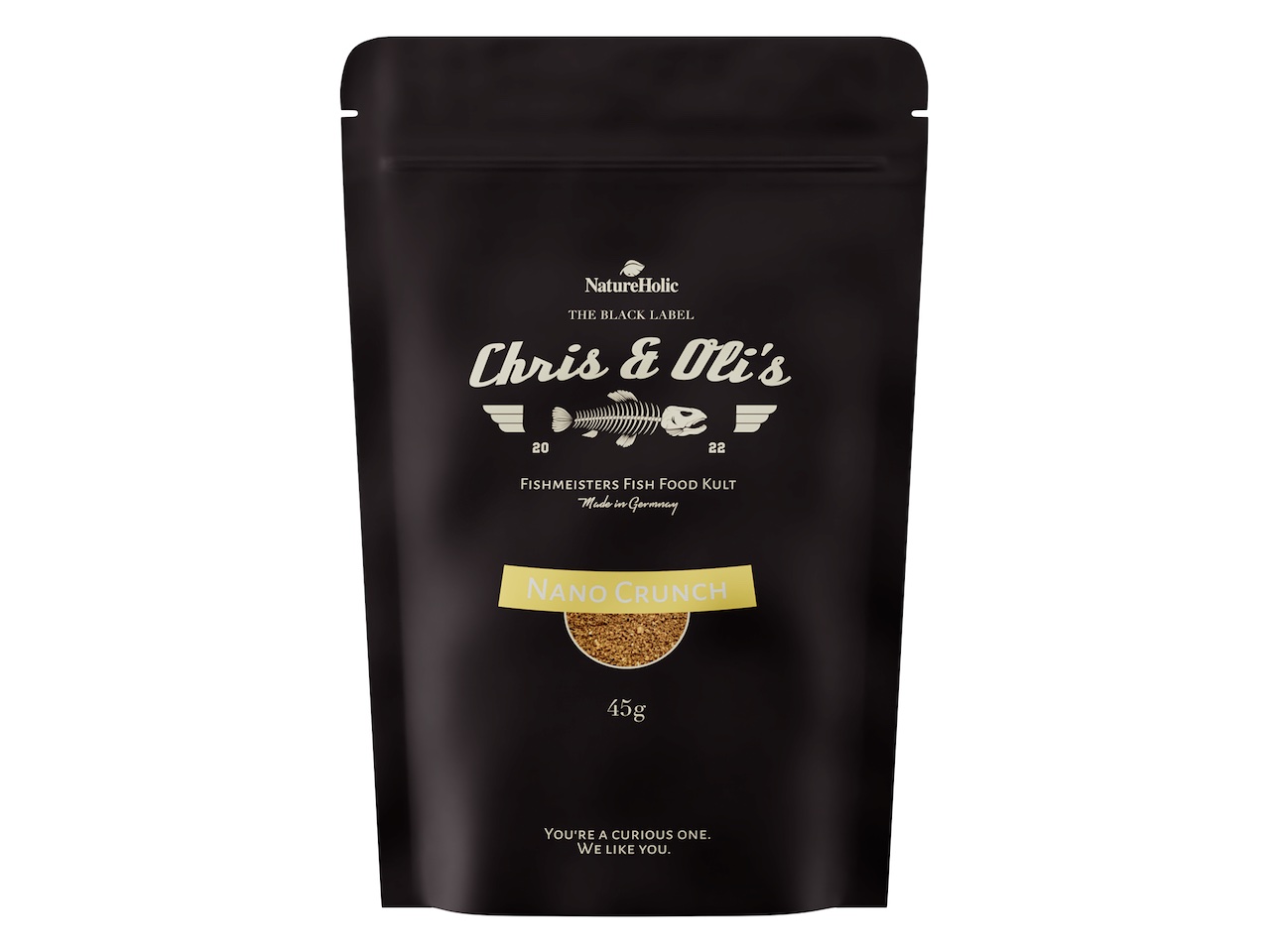
Nano Dust
The same valuable ingredients, but this time micro-ground - with the fine and especially tasty dust food Chris and Oli's Soft N Crunchy by NatureHolic you can give your smallest nano fish and fish larvae a special treat and help your baby fish get off to a good start. Also perfect for filter feeders like fan shrimp or piano snails.
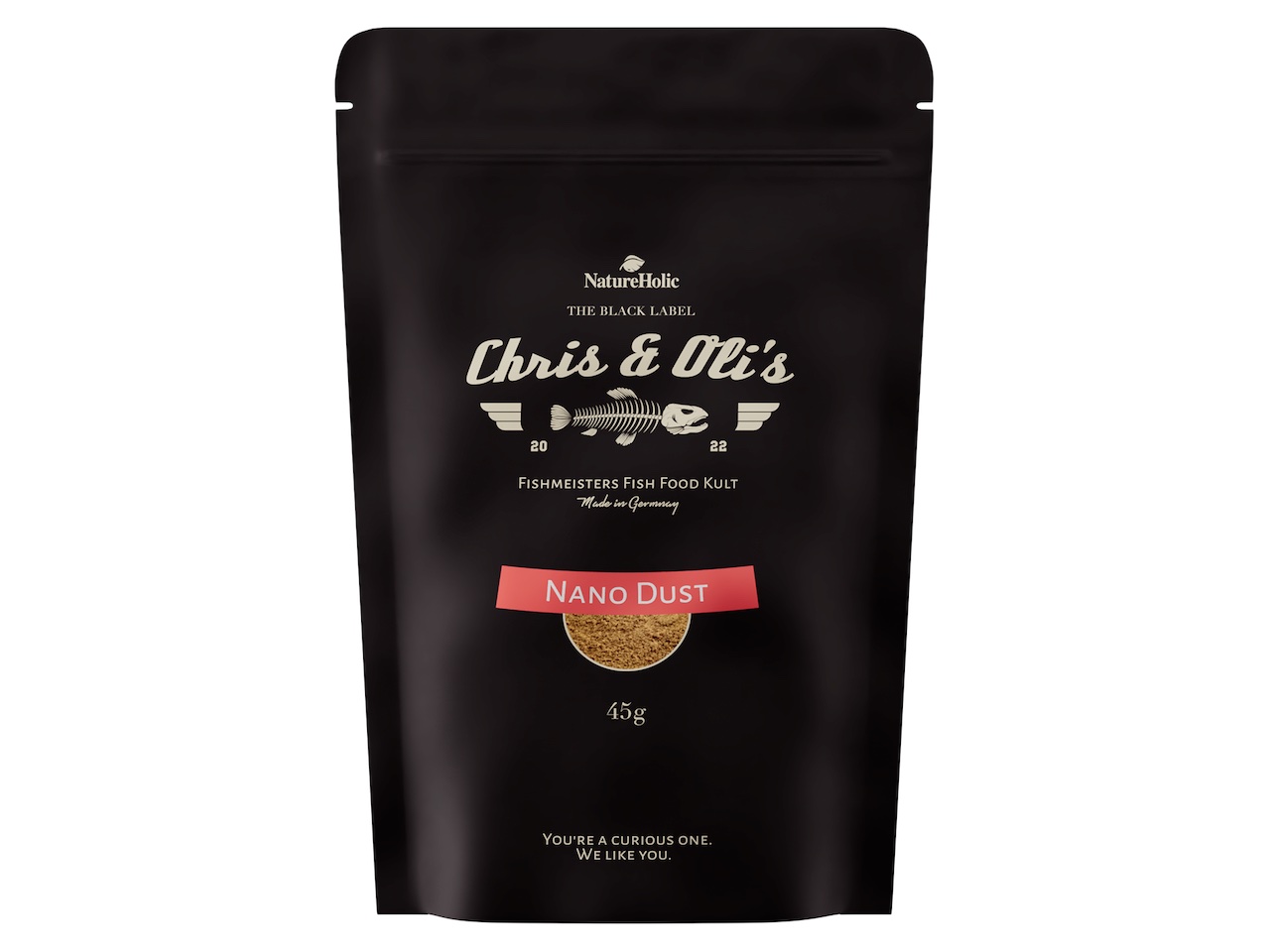
Soft N Crunchy
The soft granules of Chris and Oli's Soft N Crunchy by NatureHolic mimic the consistency of fresh insects and crustaceans and give your omnivorous ornamental fish in the aquarium a feeding experience like in nature.
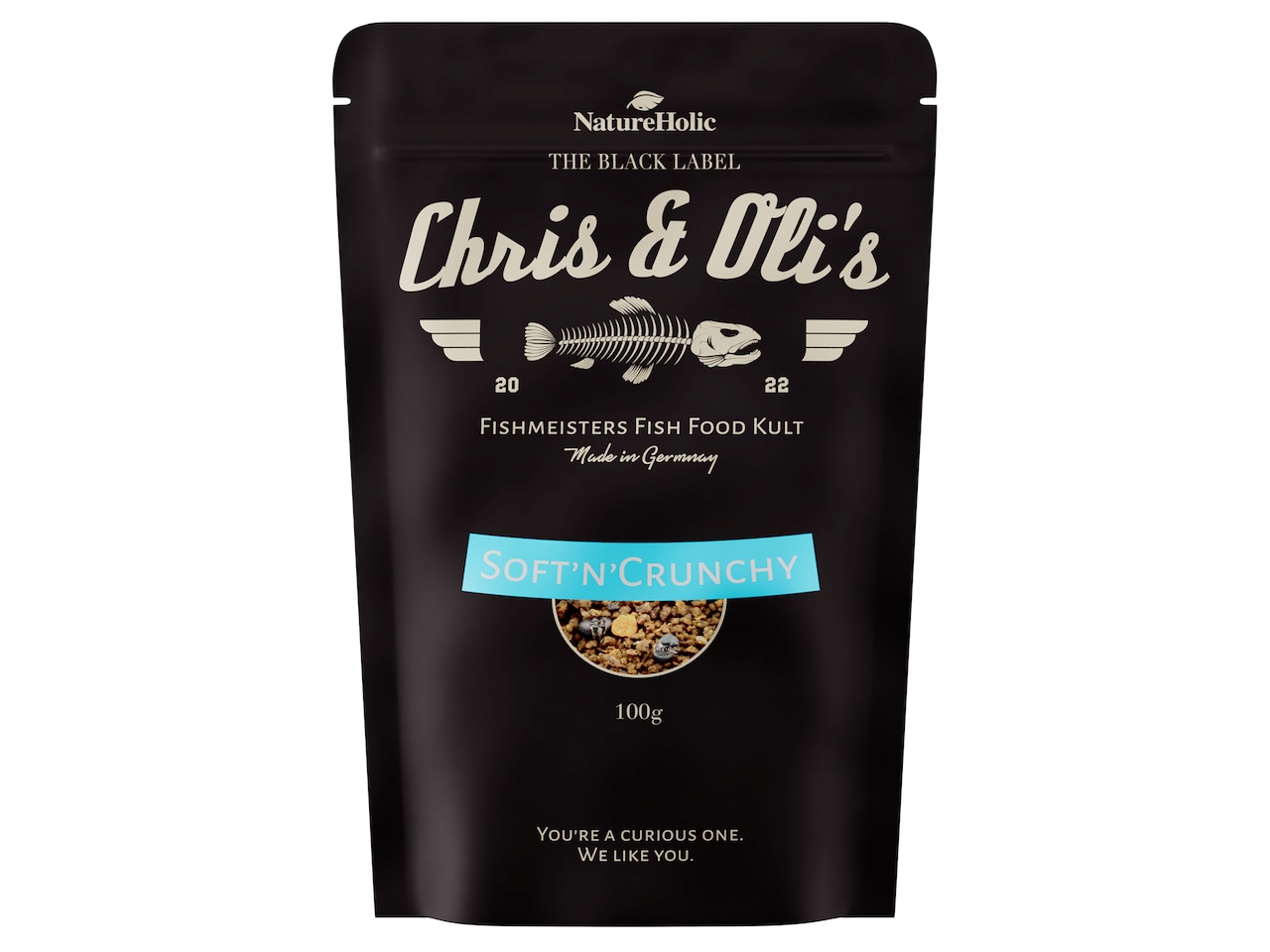
Softdrops
The fast sinking drops are especially designed for limnivorous and omnivorous catfish and other bottom-dwelling fish that scrape their food off hard surfaces. Here your bottom dwelling fish can scrape off their food for a natural feeding experience.
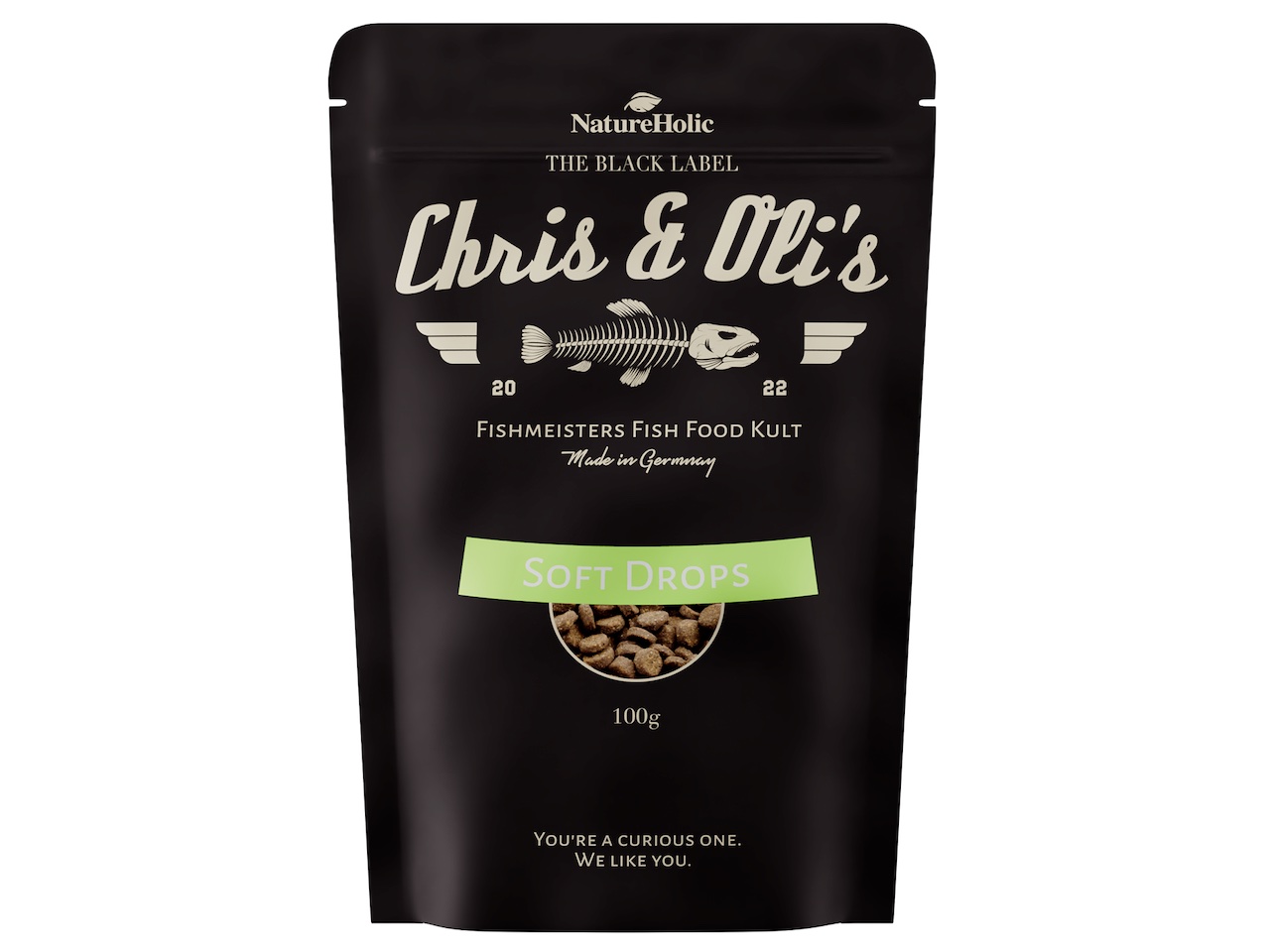
Crunchy Cream
Chris and Oli's Crunchy Cream by NatureHolic is a spreadable food paste that can be spread on all hard surfaces, such as hard rocks. This is a super natural food, not only for growth-eating catfish, which forms a feeding lawn that your growth eaters can graze on with relish. Racing snails and shrimps will also simply love Crunchy Cream!
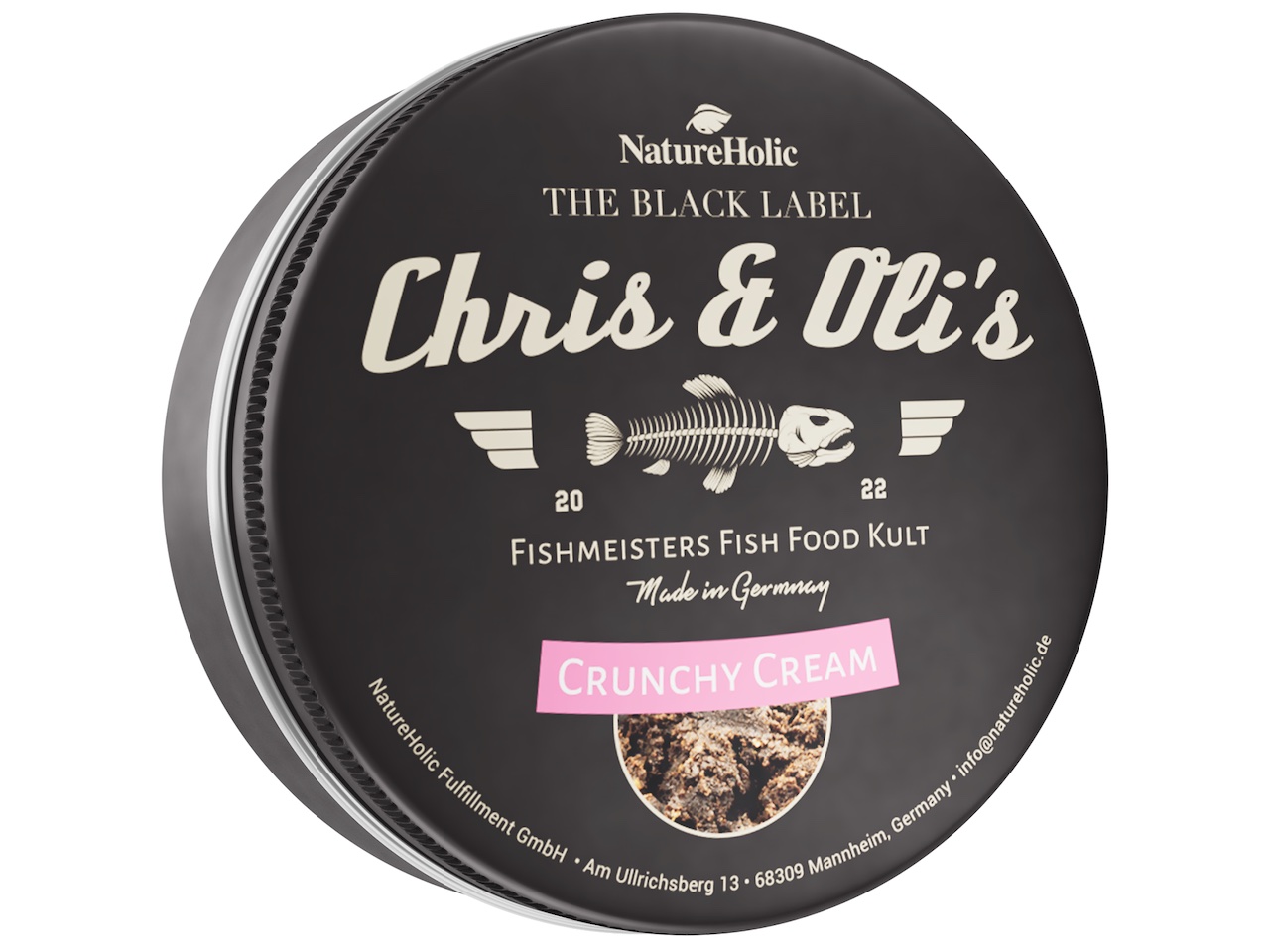
Epilogue
Now it remains for us to wish you lots of fun trying out the different types of fish food and your fish in the aquarium a good appetite!
